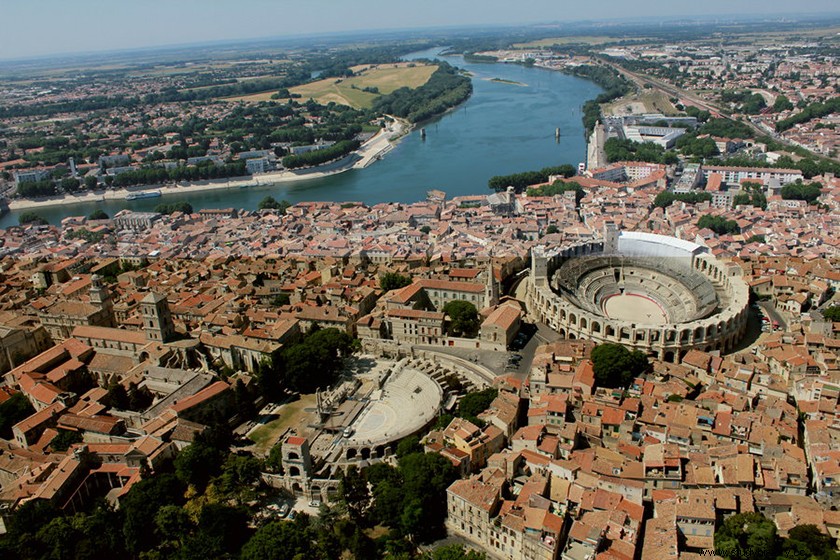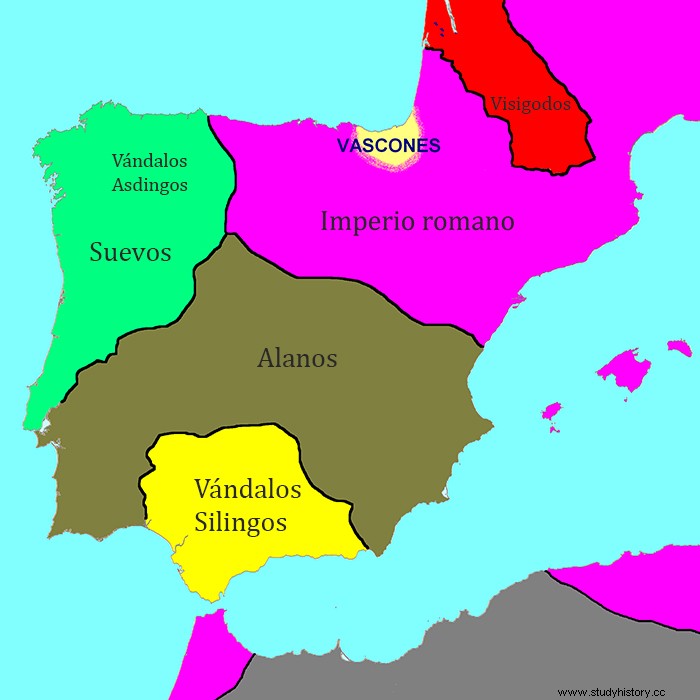
We return in Walking through History to the convulsive fifth century d. C., one of the most exciting in history and that produced a remarkable change at all levels in much of Europe. Today we will focus on the days, in which the Barbarian Peoples decided to divide Hispania. This was undoubtedly one of the most important regions of the Empire in various social, cultural and economic aspects.
The story begins on December 31 of the year 406, when the frozen waters of the Rhine allowed the passage of thousands of barbarians, the place chosen by them was the outskirts of the German city of Mainz. Immediately afterwards, the north of Gaul was involved in a maelstrom of destruction, its cities one after another were razed and looted due to the ineffectiveness of the Imperial power. The vandal Stilicho, de facto owner of the Western part of the Empire as protector of the young Emperor Honorius, had enough to defend himself against the Gothic enemy, by the way, the problem he had was twofold; Radagaisus and Alaric. Faced with such a situation, the rest of the western provinces had to manage on their own.
Constantine III, the usurper, against Gerontius
In this context, one of the protagonists of the cast of the barbarians of Hispania will emerge. He will come from afar, specifically from the Britannia province. If Gaul was in chaos, in Britain the situation was not very different, abandoned by the central power, with the legions evacuated, the defense of the cities had been left in the hands of small garrisons.
Barbarian groups came to the Romans of Britannia from different parts, on the same island they had to defend themselves against Picts, Saxons and Scots. If the protagonists of the rupture of the Rhine, it occurred to them to move from Gaul to Britain, they would have found themselves trapped very far from the central power. The solution was to take action, Constantine of unknown origin and position was proclaimed Western emperor by his men. His intentions to stop the barbarians on the mainland. And if all went well, try to gain control of the other three western provinces, that is, in addition to Britannia, Gaul and Hispania. If he succeeded, he would emulate one of his predecessors, Magno Máximo, who two decades earlier achieved it for a short period of time.
So it was that at the beginning of the year 407, Constantine III entered Gaul after crossing the English Channel, he soon encountered Suebi, Vandals, Alans and Burgundians, whom he which he apparently held in northern Gaul for a time.

Solid gold of Constantine III
Hispania was still beyond the reach of the barbarian peoples, Gaul was a great mattress, but we cannot forget that it was one of the regions with the most resources of the Empire, Constantine III was aware of this. After settling in Arles, in southern Gaul, he decides to set up his own Imperial structure, designating his son Constant, Caesar and therefore his successor, and Gerontius magister militum . The next step was to send men he trusted to Hispania, who would usurp the power of the cities from those previously appointed by Emperor Honorius.

Honorius, a boy when he is appointed Western Emperor
At this point we can make a point to ask ourselves why the Hispanic legions did not take action on the matter, most likely they were in northern Italy, at Stilicho's service in his fight to contain the Goths.
In this context, the brothers Dídimo and Veriniano emerged in Hispania (I invite you to learn about their history in this article). Strong supporters of Emperor Honorius, with whom they were possibly related. His mission was to protect Hispania from both the barbarians and the usurper Constantine III himself. His response was to send Constante and Geroncio to Hispania, both at the head of a large army that they placed in Caesarauguta . From where they control much of Hispania, and end with the two Hispanic brothers who are arrested and sent to Arles. Thus, many of the Hispanic hopes of getting rid of the barbarians vanished.
After the arrest of the two brothers Constante returns to the procession that transported them to Arles, while Geroncio remains in Hispania for the definitive control of him. In that autumn of the year 408, the barbarians who, as mercenaries, made up Gerontius's army are already beginning to wreak havoc on the rich villas of the Hispanic plateau. These same ones are the new ones in charge of the defense of Hispania from the barbarian peoples, going on to control the border posts of the Pyrenees. Ultimately, the defense of Hispania remains in the hands of the barbarians who make up the armies of a usurper, and in case any other component is missing, General Geroncio decides to take a step forward by appointing a new emperor, in this case his son –or At least that's what it seems– Maximum.
The invasion of the barbarian peoples of Hispania.
The moment in which Gerontius names Maximus the new emperor is very confused in the sources, it is not known if it is cause or effect. The truth is that again an army of Constantine III, commanded by his son Constante and a new magister militum Justino, they face Geroncio's in Hispania. Both, in need of military troops, find them among the barbarian peoples that roam Gaul, and that at that time had already approached the Pyrenean passes. From that moment it is impossible to differentiate between the barbarians who defended the border, those who tried to cross it, or those who made up the remains of the opposing Roman armies. If there was, as some sources point out, a pact with Gerontius, for history it may remain insubstantial, what is palpable is that the Pyrenees became a sieve and the barbarian peoples began to roam Hispania at will.
All this before the look away from three emperors. Let's recap; Hororio the official emperor and from the year 408 without Stilicón's right hand, defending himself from the Goths and Constantine III who was heading towards Italy. Constantine III himself, who was fighting on two fronts, in addition to the one appointed from Italy, had sent his son to Hispania, against the third party in contention, such Máximo, who we only know about him was the escape that Geroncio needed to prevail in Hispania .
The main city of the story is Arles. Geroncio defeats Constantine and goes to the Gallic city which he begins to besiege to finish off Constantine. While this before the inexorable advance of the imperial armies of Honorius tries to take refuge in a church, it did not help him, he is arrested and executed on the way to Ravenna, at that time the capital of the Empire. After that Geroncio, who should not have thought that he was going to find the opposition of Honorio, decides to return to Hispania, his men abandon him, and he has no choice but to commit suicide. We knew little about Máximo, and we will know even less from that moment on. This part of history took place between the years 409-411, two years that Hispania was at the expense of the barbarian peoples.

Arles, in the south of France-very important in the Lower Empire-
In those two years the sources of the time are very confusing. One of them was Bishop Hydacio, who two decades after the disaster narrated that the plague, massacres and famine joined the barbarians to put an end to Roman Hispania. They were not alone; the armies of Geroncio, Constantino III, or even of Honorio needed enormous amounts of resources. Collectors toured the Roman villas of the Peninsula in search of stealing everything stored by Hispanic farmers and ranchers.
The money to pay the mercenaries of the armies came from the Hispanic cities, with all their citizens confined within them. No written sources are needed, the hidden treasures found from this time are unequivocal, it was the only solution to avoid being left in complete ruin. It is not surprising what the Christian priest Orosio tells us, another of the sources and who lived those moments in the first person;
“many Roman citizens preferred to have poverty and freedom among the barbarians than to live as taxed Romans.”

The priest Osorio
The distribution of Roman Hispania among the barbarian peoples is one of those moments in history that, due to its transcendence, is worth imagining and narrating within the world of speculation. It is not difficult to imagine the military leaders of the Suebi, Alans and Vandals gathered in a great circle built by carts pulled by large oxen, the place for sure was a large green meadow.
After that day the Asdingo vandals and the Swabians they shared the road to the province of “Gallaecia ”. The silingo vandals headed south to take over the rich “Baetica ”. Finally, a part of the alanos crossed the plateau towards “Lusitania ”, the rest went to the “Carthaginensis”. Only the “Tarraconensis ” remained in the hands of Rome.

The distribution of the barbarian peoples of Hispania
According to Hidacio, what happened in that supposed green meadow was a draw. Most historians doubt that this assumption was viable. In short, it only remains for us to think that, if it was really true that Roman Hispania was divided by a division, this gave a very compromised result for the near future. In one way or another, what remained of the 5th century was one of the darkest passages in the history of the Peninsula and one that we will try to continue shedding light on in subsequent articles.
Recommended reading:



More info:
Ancient history of the Iberian Peninsula, late imperial and Visigoth times, J. J. Sayas Abengochea and Manuel Abad Valera, Ed. Uned 2013
The Fall of the Roman Empire, Adrian Goldswhorty, Ed. The Sphere of Books, 2009
The new power options:The role of the barbarians in Hispania in the 5th century, Purification Ubric Rabaneda.
